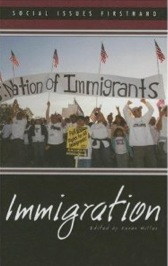December 2011 – Volume 15, Number 3
Immigration (Social Issues Firsthand) |
|||
| Author: | Karen Miller, (Ed.) (2006) |  |
|
| Publisher: | Greenhaven Press | ||
| Pages | ISBN | Price | |
|---|---|---|---|
| 110 pages | 978-0737728934 | $31.80 USD | |
Immigration, edited by Karen Miller, is a book in the series called “Social Issues Firsthand” which is intended for a young adult or middle school audience. The book contains personal narratives from a wide variety of individuals who have lived experiences of immigrating to the United States.
As the forward explains, the intent of the “Social Issues Firsthand” series is not an avenue for debate, persuasion, or a source of statistics. Rather, this text and the others in the series provide “a forum for the often-overlooked human perspectives on society’s most divisive topics of debate.”
The introduction does an excellent job of providing background information on immigration so that adolescents can begin to fathom the reasons why people leave their home country and culture to come live in the United States. Readers get a thorough theoretical description of what an immigrant goes through once they arrive in our country, such as starting from scratch, the process of acculturation (the ability to function in another culture without displacing a prior cultural identity, and the decision to stay and become a citizen or return to their home country.
Chapter 1 is titled “Finding a Place in a New Land”. It contains an account of a young girl who left Cuba with her family in 1980, a young Vietnamese man and his brother who escaped Vietnam in the 1908’s in order to avoid mandatory military service, a Bosnian teen who came to the U.S with her family to join her father who had been working here for a few years, and two brothers who came with their family to escape war in Ethiopia. Each narrative begins with some background information on the particular situation each author is leaving as well as current information on the author’s life and whereabouts. The narratives in this section focus on the decision to leave the home country, how they immigrated, and what happened to them shortly after they arrived in the U.S.
In Chapter 2 “Adapting to the American Way of Life,” the authors in this section reflect on adjusting to the differences between how they were used to living and adapting to life in the U.S. Authors in this section are a college student who came from India in the 1990’s to attend college, a Chinese woman who came her American husband in 2005, and a young man from Mongolia who came in 2005 to go to college.
In Chapter 3, “Caught Between Cultures,” the authors take a slightly different spin on immigration than Chapter 2. This section focuses more on identity and how the authors struggled and continue to struggle with merging their former identities with becoming “American”. Authors in this section include a Russian Jew who came to the U.S. in 1981 when she was in first grade, a Nicaraguan woman and her son who left in 1988, a woman from India who had also lived in Singapore and has returned to India, and an Iranian woman that graduated from Berkeley who came to the U.S. when she was seven.
The final chapter, “America’s Benefits,” highlights three stories about men whose lives change dramatically once they arrive in the U.S. One is a Laotian who received medical care which restored 35% of his hearing, another is from Mexico who discovered that making time to study is the key to success, and a man from Austria who became a bodybuilder, actor, and governor of California.
Appendices contain a list of organizations that deal with immigration, a list of book and periodicals for further research as well as an index.
Children of immigration in ES/FL and mainstream middle grades coursework and their non-immigrant peers can benefit from this book. The narratives are so personal and engaging that any reader can feel and connect with the challenges that the authors have experienced. Adolescents who have not immigrated will develop empathy for newcomers. All will find inspiration.
Reviewed by
Sheryl Pate
Lexington City Schools, North Carolina
<spate![]() lexcs.org>
lexcs.org>
| © Copyright rests with authors. Please cite TESL-EJ appropriately.
Editor’s Note: The HTML version contains no page numbers. Please use the PDF version of this article for citations. |

